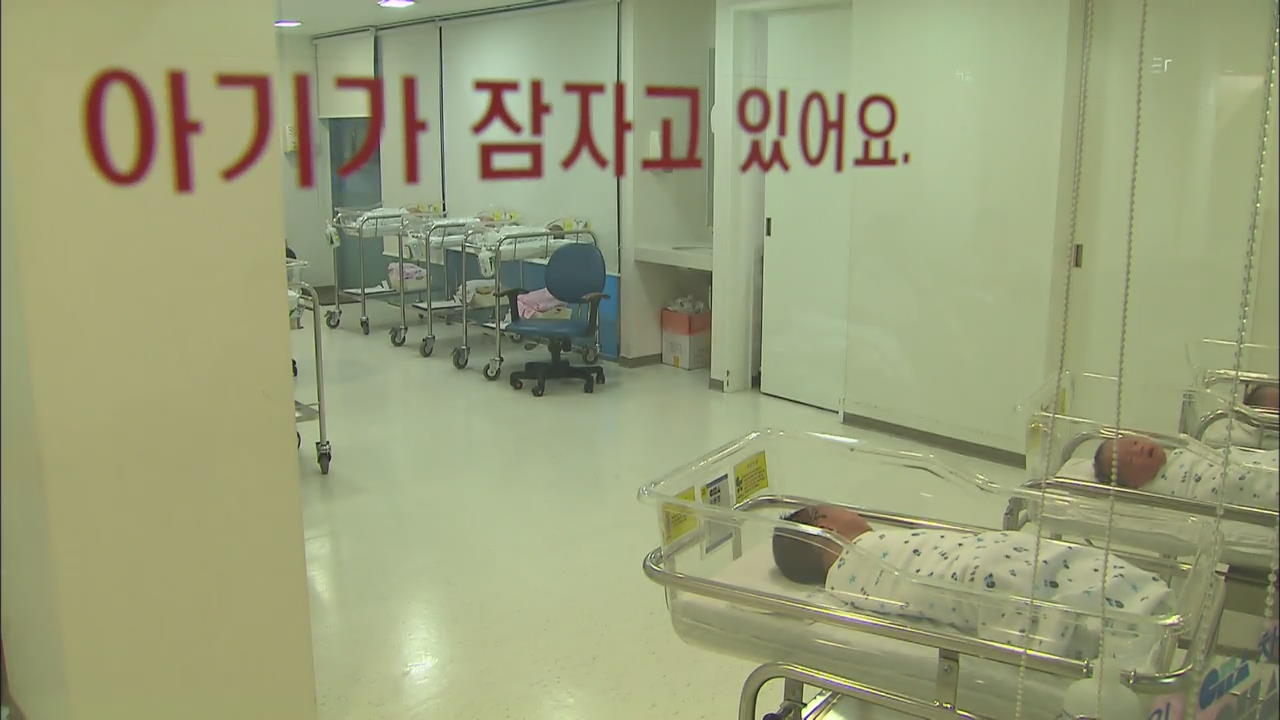Low Birthrate Problem
입력 2017.08.16 (14:06)
수정 2017.08.16 (14:20)
읽어주기 기능은 크롬기반의
브라우저에서만 사용하실 수 있습니다.
[Anchor Lead]
The Korean government has spent more than 100 trillion won over the past 11 years to solve Korea's low birthrate problem. Despite the money and effort, Korea's birthrate has continued its decline and the number of babies born this year is expected to fall under 400,000 for the first time in recent history, prompting policy advisers to review birthrate policies from square one.
[Pkg]
This is a obstetrician's clinic in the Seoul metropolitan area. It's been six years since a baby's cry was heard here. The newborn unit remains dark and obstetric equipment gathers dust. In Korea an average of some 100 obstetrics clinics close their doors every year.
[Soundbite] Dr. Lee Gi-cheo (OB, GYN) : "I worry that things will get tougher. What's more frustrating is that there's no real solution."
The Presidential Committee on Ageing Society and Population Policy overseeing the efforts to solve Korea's low birth rate problem has essentially been non-functioning. During the previous administration, only two meetings were presided by the president. Until recently only four out of 24 committee members were women, making it difficult for the committee to deal properly with issues over childbirth and childcare.
[Soundbite] Yu Yeong-sang(Incheon Resident) : "I wish there were policies that actually made it easier for parents to work and raise their children."
However, the committee's composition will change dramatically to include more civilians and thus incorporate opinions from the real world.
[Soundbite] Lee Dong-wuk(Office for Population Policy, Ministry of Health and Welfare) : "A civilian committee head will be put in place to incorporate more opinions from various fields and to carry out more practical measures."
The government plans to spend 24 trillion won this year to help boost the nation's low birthrate.
The Korean government has spent more than 100 trillion won over the past 11 years to solve Korea's low birthrate problem. Despite the money and effort, Korea's birthrate has continued its decline and the number of babies born this year is expected to fall under 400,000 for the first time in recent history, prompting policy advisers to review birthrate policies from square one.
[Pkg]
This is a obstetrician's clinic in the Seoul metropolitan area. It's been six years since a baby's cry was heard here. The newborn unit remains dark and obstetric equipment gathers dust. In Korea an average of some 100 obstetrics clinics close their doors every year.
[Soundbite] Dr. Lee Gi-cheo (OB, GYN) : "I worry that things will get tougher. What's more frustrating is that there's no real solution."
The Presidential Committee on Ageing Society and Population Policy overseeing the efforts to solve Korea's low birth rate problem has essentially been non-functioning. During the previous administration, only two meetings were presided by the president. Until recently only four out of 24 committee members were women, making it difficult for the committee to deal properly with issues over childbirth and childcare.
[Soundbite] Yu Yeong-sang(Incheon Resident) : "I wish there were policies that actually made it easier for parents to work and raise their children."
However, the committee's composition will change dramatically to include more civilians and thus incorporate opinions from the real world.
[Soundbite] Lee Dong-wuk(Office for Population Policy, Ministry of Health and Welfare) : "A civilian committee head will be put in place to incorporate more opinions from various fields and to carry out more practical measures."
The government plans to spend 24 trillion won this year to help boost the nation's low birthrate.
■ 제보하기
▷ 카카오톡 : 'KBS제보' 검색, 채널 추가
▷ 전화 : 02-781-1234, 4444
▷ 이메일 : kbs1234@kbs.co.kr
▷ 유튜브, 네이버, 카카오에서도 KBS뉴스를 구독해주세요!
- Low Birthrate Problem
-
- 입력 2017-08-16 14:07:46
- 수정2017-08-16 14:20:28

[Anchor Lead]
The Korean government has spent more than 100 trillion won over the past 11 years to solve Korea's low birthrate problem. Despite the money and effort, Korea's birthrate has continued its decline and the number of babies born this year is expected to fall under 400,000 for the first time in recent history, prompting policy advisers to review birthrate policies from square one.
[Pkg]
This is a obstetrician's clinic in the Seoul metropolitan area. It's been six years since a baby's cry was heard here. The newborn unit remains dark and obstetric equipment gathers dust. In Korea an average of some 100 obstetrics clinics close their doors every year.
[Soundbite] Dr. Lee Gi-cheo (OB, GYN) : "I worry that things will get tougher. What's more frustrating is that there's no real solution."
The Presidential Committee on Ageing Society and Population Policy overseeing the efforts to solve Korea's low birth rate problem has essentially been non-functioning. During the previous administration, only two meetings were presided by the president. Until recently only four out of 24 committee members were women, making it difficult for the committee to deal properly with issues over childbirth and childcare.
[Soundbite] Yu Yeong-sang(Incheon Resident) : "I wish there were policies that actually made it easier for parents to work and raise their children."
However, the committee's composition will change dramatically to include more civilians and thus incorporate opinions from the real world.
[Soundbite] Lee Dong-wuk(Office for Population Policy, Ministry of Health and Welfare) : "A civilian committee head will be put in place to incorporate more opinions from various fields and to carry out more practical measures."
The government plans to spend 24 trillion won this year to help boost the nation's low birthrate.
The Korean government has spent more than 100 trillion won over the past 11 years to solve Korea's low birthrate problem. Despite the money and effort, Korea's birthrate has continued its decline and the number of babies born this year is expected to fall under 400,000 for the first time in recent history, prompting policy advisers to review birthrate policies from square one.
[Pkg]
This is a obstetrician's clinic in the Seoul metropolitan area. It's been six years since a baby's cry was heard here. The newborn unit remains dark and obstetric equipment gathers dust. In Korea an average of some 100 obstetrics clinics close their doors every year.
[Soundbite] Dr. Lee Gi-cheo (OB, GYN) : "I worry that things will get tougher. What's more frustrating is that there's no real solution."
The Presidential Committee on Ageing Society and Population Policy overseeing the efforts to solve Korea's low birth rate problem has essentially been non-functioning. During the previous administration, only two meetings were presided by the president. Until recently only four out of 24 committee members were women, making it difficult for the committee to deal properly with issues over childbirth and childcare.
[Soundbite] Yu Yeong-sang(Incheon Resident) : "I wish there were policies that actually made it easier for parents to work and raise their children."
However, the committee's composition will change dramatically to include more civilians and thus incorporate opinions from the real world.
[Soundbite] Lee Dong-wuk(Office for Population Policy, Ministry of Health and Welfare) : "A civilian committee head will be put in place to incorporate more opinions from various fields and to carry out more practical measures."
The government plans to spend 24 trillion won this year to help boost the nation's low birthrate.
이 기사가 좋으셨다면
-
좋아요
0
-
응원해요
0
-
후속 원해요
0













![[영상] 무단침입에, 주행 중 <br>찰칵? 불꽃축제 이후…](/data/fckeditor/vod/2024/10/06/306961728217699214.jpg)



이 기사에 대한 의견을 남겨주세요.